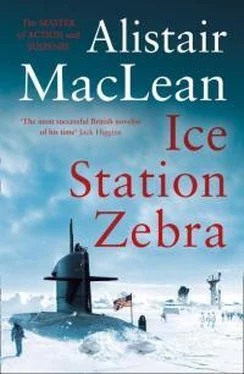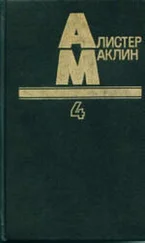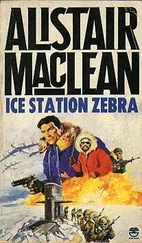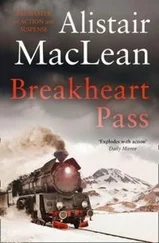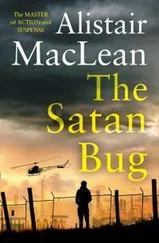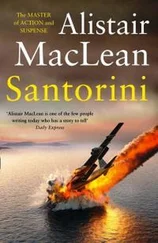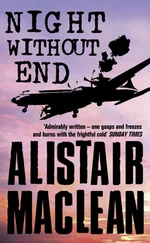‘Nicely,’ Swanson murmured. ‘Very nicely done indeed. Both ahead one-third. I hope that bang had considerably more effect on the ice than it had on our ship.’ He said to Benson at the ice-machine: ‘Let us know as soon as we reach the lead, will you?’
He moved to the plotting table. Raeburn looked up and said: ‘Five hundred yards gone, five hundred to go.’
‘All stop,’ Swanson said. The slight vibration of the engine died away. ‘We’ll just mosey along very carefully indeed. That explosion may have sent blocks of ice weighing a few tons apiece pretty far down into the sea. I don’t want to be doing any speed at all if we meet any of them on the way up.’
‘Three hundred yards to go,’ Raeburn said.
‘All clear. All clear all round,’ the sonar room reported.
‘Still thick ice,’ Benson intoned. ‘Ah! That’s it. We’re under the lead. Thin ice. Well, five or six feet.’
‘Two hundred yards,’ Raeburn said. ‘It checks.’
We drifted slowly onwards. At Swanson’s orders the propellers kicked over once or twice then stopped again.
‘Fifty yards,’ Raeburn said. ‘Near enough.’
‘Ice reading?’
‘No change. Five feet, about.’
‘Speed?’
‘One knot.’
‘Position?’
‘One thousand yards exactly. Passing directly under target area.’
‘And nothing on the ice-machine. Nothing at all?’
‘Not a thing.’ Benson shrugged and looked at Swanson. The captain walked across and watched the inked stylus draw its swiftly etched vertical lines on the paper.
‘Peculiar, to say the least of it,’ Swanson murmured. ‘Seven hundred pounds of very high-grade amatol in that lot. Must be uncommonly tough ice in those parts. Again to say the least of it. We’ll go up to ninety feet and make a few passes under the area. Floodlights on, TV on.’
So we went up to ninety feet and made a few passes and nothing came of it. The water was completely opaque, the floods and camera useless. The ice-machine stubbornly registered four to six feet – it was impossible to be more accurate – all the time.
‘Well, that seems to be it,’ Hansen said. ‘We back off and have another go?’
‘Well, I don’t know,’ Swanson said pensively. ‘What say we just try to shoulder our way up?’
‘Shoulder our way up?’ Hansen wasn’t with him: neither was I. ‘What kind of shoulder is going to heave five feet of ice to one side?’
‘I’m not sure. The thing is, we’ve been working from unproved assumptions and that’s always a dangerous basis. We’ve been assuming that if the torpedo didn’t blow the ice to smithereens it would at least blow a hole in it. Maybe it doesn’t happen that way at all. Maybe there’s just a big upward pressure of water distributed over a fair area that heaves the ice up and breaks it into pretty big chunks that just settle back into the water again in their original position in the pattern of a dried-up mud hole with tiny cracks all round the isolated sections. But with cracks all round. Narrow cracks, but there. Cracks so narrow that the ice-machine couldn’t begin to register them even at the slow speed we were doing.’ He turned to Raeburn. ‘What’s our position?’
‘Still in the centre of the target area, sir.’
‘Take her up till we touch the ice,’ Swanson said.
He didn’t have to add any cautions about gentleness. The diving officer took her up like floating thistledown until we felt a gentle bump.
‘Hold her there,’ Swanson said. He peered at the TV screen but the water was so opaque that all definition vanished half-way up the sail. He nodded to the diving officer. ‘Kick her up – hard.’
Compressed air roared into the ballast tanks. Seconds passed without anything happening then all at once the Dolphin shuddered as something very heavy and very solid seemed to strike the hull. A moment’s pause, another solid shock then we could see the edge of a giant segment of ice sliding down the face of the TV screen.
‘Well, now, I believe I might have had a point there,’ Swanson remarked. ‘We seem to have hit a crack between two chunks of ice almost exactly in the middle. Depth?’
‘Forty-five.’
‘Fifteen feet showing. And I don’t think we can expect to lift the hundreds of tons of ice lying over the rest of the hull. Plenty of positive buoyancy?’
‘All we’ll ever want.’
‘Then we’ll call it a day at that. Right, Quartermaster, away you go up top and tell us what the weather is like.’
I didn’t wait to hear what the weather was like. I was interested enough in it, but I was even more interested in ensuring that Hansen didn’t come along to his cabin in time to find me putting on the Mannlicher-Schoenauer along with my furs. But this time I stuck it not in its special holster but in the outside pocket of my caribou trousers. I thought it might come in handier there.
It was exactly noon when I clambered over the edge of the bridge and used a dangling rope to slide down a great rafted chunk of ice that slanted up almost to the top of the sail. The sky had about as much light in it as a late twilight in winter when the sky is heavy with grey cloud. The air was as bitter as ever, but the weather had improved for all that. The wind was down now, backed round to the north-east, seldom gusting at more than twenty m.p.h., the ice-spicules rising no more than two or three feet above the ice-cap. Nothing to tear your eyes out. To be able to see where you were going on that damned ice-cap made a very pleasant change.
There were eleven of us altogether – Commander Swanson himself, Dr Benson, eight enlisted men and myself. Four of the men were carrying stretchers with them.
Even seven hundred pounds of the highest grade conventional explosive on the market hadn’t managed to do very much damage to the ice in that lead. Over an area of seventy yards square or thereabouts the ice had fractured into large fragments curiously uniform in size and roughly hexagonal in shape but fallen back so neatly into position that you couldn’t have put a hand down most of the cracks between the adjacent fragments of ice: many of the cracks, indeed, were already beginning to bind together. A poor enough performance for a torpedo war-head – until you remembered that though most of its disruptive power must have been directed downwards it had still managed to lift and fracture a chunk of ice-cap weighing maybe 5,000 tons. Looked at in that way, it didn’t seem such a puny effort after all. Maybe we’d been pretty lucky to achieve what we had.
We walked across to the eastern edge of the lead, scrambled up on to the ice-pack proper and turned round to get our bearings, to line up on the unwavering white finger of the searchlight that reached straight up into the gloom of the sky. No chance of getting lost this time. While the wind stayed quiet and the spicules stayed down you could see that lamp in the window ten miles away.
We didn’t even need to take any bearings. A few steps away and up from the edge of the lead and we could see it at once. Drift Station Zebra. Three huts, one of them badly charred, five blackened skeletons of what had once been huts. Desolation.
‘So that’s it,’ Swanson said in my ear. ‘Or what’s left of it. ‘I’ve come a long way to see this.’
‘You nearly went a damned sight longer and never saw it,’ I said. ‘To the floor of the Arctic, I mean. Pretty, isn’t it?’
Swanson shook his head slowly, moved on. There were only a hundred yards to go. I led the way to the nearest intact hut, opened the door and passed inside.
The hut was about thirty degrees warmer than the last time I had been there, but still bitterly cold. Only Zabrinski and Rawlings were awake. The hut smelt of burnt fuel, disinfectant, iodine, morphine and a peculiar aroma arising from a particularly repulsive looking hash that Rawlings was industriously churning around in a dixie over the low stove.
Читать дальше
Конец ознакомительного отрывка
Купить книгу
